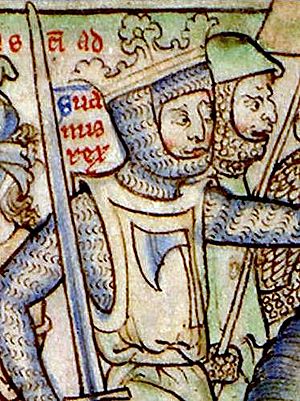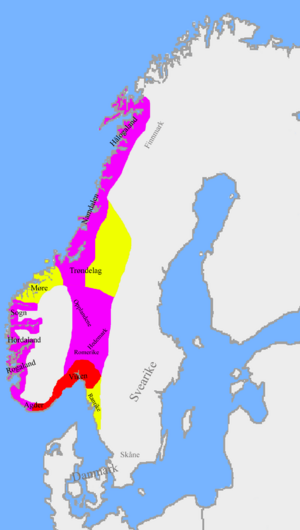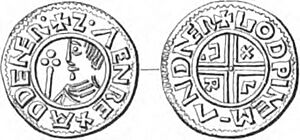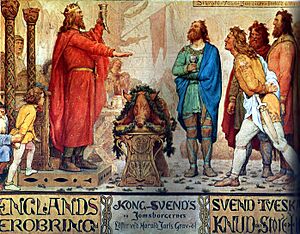Sweyn Forkbeard facts for kids
Quick facts for kids Sweyn Forkbeard |
|
|---|---|

Sweyn (Suanus rex) invading England in 1013 (detail of a 13th-century miniature). Cambridge University Library.
|
|
| King of Denmark | |
| Reign | 986–1014 |
| Predecessor | Harald Bluetooth |
| Successor | Harald II |
| King of Norway | |
| Reign |
|
| Predecessor | |
| Successor | Olaf II |
| King of England | |
| Reign | 1013–1014 |
| Predecessor | Æthelred |
| Successor | Æthelred |
| Born | c. 960 Denmark |
| Died | 3 February 1014 (aged 53-54) Gainsborough, Lincolnshire, England |
| Burial | Roskilde Cathedral or St. Trinity in Lund |
| Spouse | Świętosława / Sigrid / Gunhild (detail) |
| Issue among others... |
|
| House | House of Denmark |
| Father | Harald Bluetooth |
| Mother | Gunhild or Tove |
Sweyn Forkbeard (born around 960 – died February 3, 1014) was a powerful Viking king. He ruled Denmark from 986 to 1014. He also became king of Norway and, for a short time, England. Sweyn was the father of two future kings, Harald II of Denmark and Canute the Great. His daughter, Estrid Svendsdatter, was also very important.
Sweyn took the Danish throne from his father, Harald Bluetooth, in the mid-980s. Harald died soon after. Later, in the year 1000, Sweyn gained control over most of Norway. In 1013, he became the first Danish king of England, just before he died.
Contents
Sweyn's Early Life and Family
Historians learn about Sweyn from old writings like the Anglo-Saxon Chronicle and the Heimskringla. These sources help us understand his life, though some details might be different in various accounts.
Sweyn's father, Harald Bluetooth, was one of the first kings in Scandinavia to become a Christian. Sweyn himself was also baptized. His mother's name is thought to be Gunhild or Tove. Sweyn married a woman named Gunhild, who was the widow of the Swedish king Erik.
Taking the Throne
Around 985, Sweyn led a revolt against his father, Harald Bluetooth. Sweyn won, and Harald had to leave the country. Harald died shortly after, in 986 or 987. Sweyn then became the new king of Denmark.
Some old stories say that Sweyn was sent away from Denmark for 14 years. However, this might not be completely true. Records show that he was building churches in Denmark during some of that time.
Battles and Control of Norway

Sweyn wanted to expand his power. He formed an alliance with the Swedish king Olof Skötkonung and a powerful Norwegian leader named Eiríkr Hákonarson. They joined forces against the Norwegian king, Olaf Tryggvason.
In September 999 or 1000, Sweyn and his allies fought King Olaf at the Battle of Svolder. This battle took place in the western Baltic Sea. Sweyn and his allies won, and King Olaf was defeated.
After the victory, they divided Norway among themselves. Sweyn took direct control of the Viken district in Norway. The other parts of Norway were ruled by Eirik Hákonarson and Svein Hákonarson, who were loyal to Sweyn and the Swedish king. These leaders were strong rulers, and Norway became prosperous under their control.
Sweyn's Invasions of England
Sweyn led many raids against England. These attacks happened between 1002 and 1012. One reason for these raids was to get revenge for the St. Brice's Day massacre in November 1002. In this event, many Danes living in England were killed. Sweyn's sister was believed to be among them. Another main reason for the raids was to gain wealth, known as Danegeld.
In 1013, Sweyn led a large invasion of England himself. He sailed with his fleet to Sandwich and quickly moved through East Anglia. He sailed up the River Humber and River Trent to Gainsborough. Many areas, including Northumbria, quickly surrendered to him.
The Anglo-Saxon Chronicle, an old English record, describes his invasion:
- Sweyn arrived in Sandwich with his fleet.
- He quickly moved through East Anglia and up the River Humber to Gainsborough.
- Many regions, including Northumbria and Lindsey, submitted to him.
- He gathered hostages from each area.
- Sweyn then went south, passing Watling Street, and reached Oxford. The people there also surrendered.
- From Oxford, he went to Winchester, where the same happened.
- Finally, he moved east towards London.
However, the people of London fought back strongly. King Æthelred and a Viking leader named Thorkell the Tall defended the city. Sweyn then went west to Bath, where more English leaders surrendered. Fearing Sweyn's revenge, the Londoners finally gave in.
King Æthelred sent his sons to Normandy and then went into exile himself. On Christmas Day in 1013, Sweyn was declared King of England. He ruled England for only five weeks. He died in Gainsborough on February 3, 1014. His body was taken back to Denmark for burial, possibly in Roskilde or Lund.
After Sweyn's Death
After Sweyn's death, his older son, Harald II of Denmark, became King of Denmark. His younger son, Canute the Great, was named King of England by the Danes living there. However, the English nobility called King Æthelred back from exile. Æthelred managed to drive Cnut out of England in the spring of 1014.
Cnut soon returned to England. He became king of all England in 1016, after Æthelred and his son died. Cnut also became King of Denmark in 1019, after his brother Harald died. Eventually, Cnut also ruled Norway and parts of Sweden.
Sweyn's daughter, Estrid Svendsdatter, was the mother of King Sweyn II of Denmark. Her family line continues to rule Denmark even today. Through marriages, Sweyn's descendants also became monarchs of Scotland and later England again.
Sweyn's Children
Sweyn had several children, including:
- Harald II of Denmark
- Canute the Great
- Estrid Svendsdatter
- Gytha
- Gunnhild
- Santslaue
- Thyra
Cultural Appearances
King Sweyn Forkbeard has appeared in movies and other media.
- He was played by Ernest Graves in the 1970 film The Ceremony of Innocence.
- He also appears in the Japanese manga series Vinland Saga.
Images for kids
-
A coin of Sweyn Forkbeard, minted in 995; this is the earliest known coin with a Latin inscription minted in Scandinavia, based on Anglo-Saxon models and made by an English moneyer (obv.: ZVEN REX AD DENER "Sven, king of [or among] the Danes", rev.: GOD-WINE M-AN D-NER "Godwine, moneyer among the Danes").
-
Division of Norway after the Battle of Svolder according to Heimskringla: The red area was under direct Danish control, with Sweyn's ruling it as a Danish extension. Eiríkr Hákonarson ruled the purple area as a fiefdom from Sweyn Forkbeard. The yellow area was under Sveinn Hákonarson, his half-brother, held as a fief of Olof Skötkonung, the Swedish king.
See also
 In Spanish: Svend I de Dinamarca para niños
In Spanish: Svend I de Dinamarca para niños







